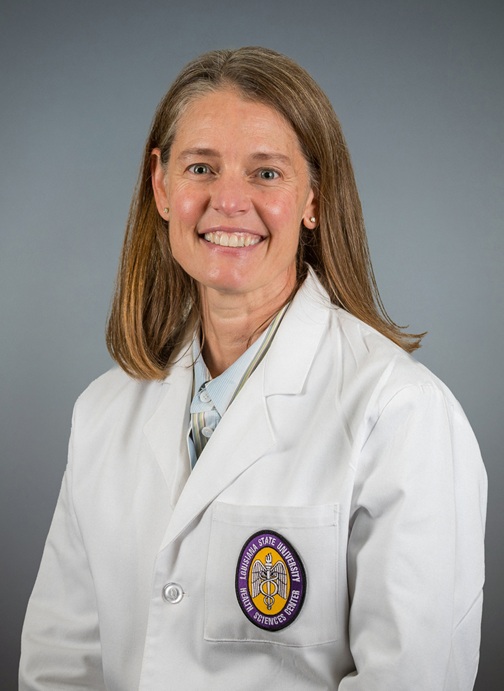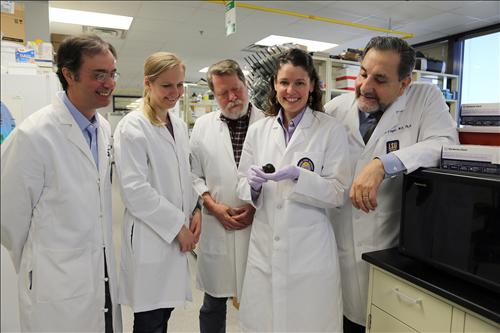
FACULTY
Jennifer J. Lentz, PhD
Associate Professor of Otorhinolaryngology, Biocommunications & Neuroscience
Adjunct Associate Professor of Ophthalmology
Neuroscience Center of Excellence
- jlentz@lsuhsc.edu
- Medicine
Academic Office:
LSUHSC School of Medicine
2020 Gravier Street, 8th Floor
New Orleans, LA 70112
Office: (504) 599-0400
Lab: (504) 599-0892
Fax: (504) 599-0891
Bio
BA, Biology and Chemistry, May 1992, Monmouth College, Monmouth, Illinois
PhD, Genetics, May, 2007, Louisiana State University Health Sciences Center, Louisiana
I am a Professor of Otorhinolaryngology, adjunct in Ophthalmology, and a member of the Neuroscience Center of Excellence at LSUHSC. The overall goals of my research are to understand the mechanisms that lead to the deafness, imbalance, and blindness associated with Usher syndrome and to develop therapeutic approaches to prevent or cure the disease.
I have developed a comprehensive approach to the study of Usher syndrome that includes a multi-disciplinary team of basic science and clinical investigators to develop therapeutic approaches for USH1C. Currently, my laboratory targets mutations in the USH1C gene with antisense, gene-replacement, lipid-nanoparticle, and CRISPR/Cas9-based gene editing therapeutic strategies using patients’ cell lines and a knock-in mouse model of Acadian Usher syndrome type 1C (USH1C).
To prepare for a future clinical trial, my team also conducts several Natural History Studies with Usher syndrome patients to better understand the molecular epidemiology and natural clinical history of the hearing, balance, and vision losses. Lastly, I host a biennial community symposium in Louisiana that brings together clinicians, researchers, patients, families, and community members affected by this rare disease to improve clinical and community knowledge and awareness of Usher syndrome.
Research
Currently, my laboratory targets mutations in the USH1C gene with antisense, gene-replacement, lipid nanoparticle, and CRISPR/Cas9-based gene editing therapies using patients’ cell lines and a knock-in mouse model of Acadian Usher syndrome type 1C (USH1C). To study mechanisms and develop therapies, I created a unique USH1C mouse model which contains the human USH1C c.216G>A mutation that causes Usher syndrome in our local population in south Louisiana. The knock-in USH1C mice have hearing, balance, and visual defects, similar to patients, which make them an excellent model to study mechanisms and develop strategies to prevent or cure deafness, imbalance, and blindness. To prepare for a future clinical trial, I have assembled a clinical team of Hearing, Balance, and Vision experts. We conduct several Natural History Studies with Usher syndrome patients to better understand the molecular epidemiology and natural clinical history of the hearing, balance, and vision losses, and define outcome measures to guide a future clinical trial.
Current Funding
Usher 2020 and Ush One See Foundations Donations (2024 – 2026)
The goal of this donation is to increase the number of participants in the ongoing
Prospective Natural History of Visual Loss in USH1C: a multi-center study by adding
additional clinical sites.
1 R01 DC020243-01A1 (MPIs: Lentz, Wu, Geleoc) (2023 – 2028)
NIH/NIDCD
Title: Vestibular dysfunction and the development of novel therapies for Usher syndrome.
The goals of this study are to determine the progression of vestibular dysfunction over time
in USH1C mice and patients, and to test the therapeutic efficacies of two novel treatments
when delivered at different stages of disease progression in the mice.
Usher 2020 and Ush One See Foundations Donations (2022)
The goals of these donations are to provide supplemental funding to improve patient
access to the NIH-R01 funded prospective USH1C Natural History Study by providing
deaf-blind interpreters and a hotel stay for study participants during clinical visits
at participating sites.
Ush One See Foundation Donation (2019)
The goals of this donation are to support activities related to the clinical evaluation of
vision in USH1C patients at the LSU Eye Center in New Orleans, Louisiana. The study
that this donation supports was delayed until 2021 due to COVID restrictions but is
now underway.
Recently Completed Funding
R01EY030499 (PI: Lentz, co-PI: Koenekoop) (2019 – 2025)
NIH/NEI
Title: Antisense therapy for the treatment of visual loss in Usher syndrome
The goals of this study are to identify the lead antisense clinical drug candidate and define
the clinical outcomes in Usher syndrome type 1C patients that could guide a clinical
trial.
Clinical Research Enhancement Program (PI: Arriaga, co-Investigator: Lentz) (2019
– 2022)
Title: Assessment of Balance and Vestibular Function in USH1C patients
The goals of this study are to define the natural clinical progression of balance dysfunction
in USH1C and determine the vestibular outcomes measures that could be used to guide
a clinical trial.
Decibel Therapeutics, Inc. Donation (2019)
The goals of this donation are to support activities related to the clinical evaluation of
balance and vestibular function in adolescent USH1C patients at the Hearing and Balance
Center in Baton Rouge, Louisiana.
Usher Syndrome in Louisiana Symposium
5TH SYMPOSIUM (2025) 4TH SYMPOSIUM (2023) 3RD SYMPOSIUM (2018) 2ND SYMPOSIUM (2016) 1ST SYMPOSIUM (2014)
Publications
Ponnath A, Depreux F, Jodelka FM, Farris HE, Rigo F, Hastings ML, Lentz JJ. Rescue of outer hair cells with antisense oligonucleotides in Usher mice is dependent on age of treatment. Journal of the Association for Research in Otolaryngology, 2017, 10.1007/s 101620017-0640-x. PMID: 29027038
S Vijayakumar, F Depreux, FM Jodelka, JJ Lentz, F Rigo, TA Jones, ML Hastings. Rescue of peripheral vestibular function in Usher syndrome mice using a splice-switching antisense oligonucleotide. Human Molecular Genetics, 2017 doi.or/10.1093/hmg/ddx234. PMID: 28633508
Pan B, Askew C, Galvin A, Haman-Ackah S, Asai Y, Indzhykulian AA, Jodelka F, Hastings ML, Lentz JJ, Vandenberghe LH, Holt JR, Geleoc GGS. Gene therapy restores auditory and vestibular function in a mouse model of Usher syndrome type IC. Nature Biotechnology, 2017 35(3):264-274. PMID: 28165476
Depreux FF, Wang L, Jiang H, Jodelka FM, Rosencrans RF, Rigo R, Lentz JJ, Brigande JV, Hastings, ML. Antisense Oligonucleotides delivered to the amniotic cavity in utero modulate gene expression in the postnatal mouse. Breakthrough Article: Nucleic Acids Research, 2016 44(20):9519-9529. PMID: 27683224
Lentz J, Jodelka FM, Hinrick AJ, McCaffrey KE, Farris HE, Spalitta MJ, Bazan NG, Duelli DM, Rigo F, Hastings ML. Rescue of hearing and vestibular function by antisense oligonucleotides in a mouse model of human deafness. Nature Medicine, 2013 19:345-350. PMID: 23380860
In the News
Cajun Strong, Community and Science Bolter lives of Deaf-Blind in Acadiana. Phyllis Boudoin Griffard. Louisiana Cultural Vistas, June 2017.
Hearing in the mouse of Usher. JV Brigande. Nature Biotechnology News and Views, February, 2017, 35(3):216-218.
Rescue from Hearing Loss in Usher's Syndrome , Karen B. Avraham, Ph.D. New England Journal of Medicine, 2013; 369:1758-1760 October 31, 2013 DOI: 10.1056/NEJMcibr1311048

Dr. Hamilton Farris, Mette Flatt, Dr. William Gordon, Dr. Jennifer Lentz and the mouse and Dr. Nicolas Bazan (the research team)
Local medical research team makes breakthrough in curing deafness. Meg Farris, WWWLTV.com, February, 4 2013.
Genetic Patch 'stops deafness' in newborn mice. J. Gallagher, BBC News Health, February 4, 2013.
Researchers Develop Rx for Deafness, Impaired Balance in Mouse Model of Usher syndrome. Provided by LSUHSC to Science Daily via EurekaAlert!, February 4, 2013.
Scientists Prevent Development of Deafness in Animals Engineered to have Usher Syndrome. Provided by RFUMC to Science Daily via EurekaAlert!, February 4, 2013.
Researchers Devolop Rx fro Deafness, Impaired Balance in Mouse Model of Usher Syndrome. Provided by LSUHSC, Science Newsline Medicine & Health Care. February 4, 2013.
Gene Therapy in mice gives hope to the deaf. A France-Presse, The Raw Story, February 4, 2013.
Partial fix for Usher syndrome found in mice. The Associated Press, USA Today, February, 9, 2013.
Molecular therapy: Deafness Diverted. Nature Publishing Group, February 13, 2013.
LSU Health Sciences Center Discovers Breakthrough Therapy to Cure Deafness. J Ballard, Silicon Bayou News, February 19, 2013
